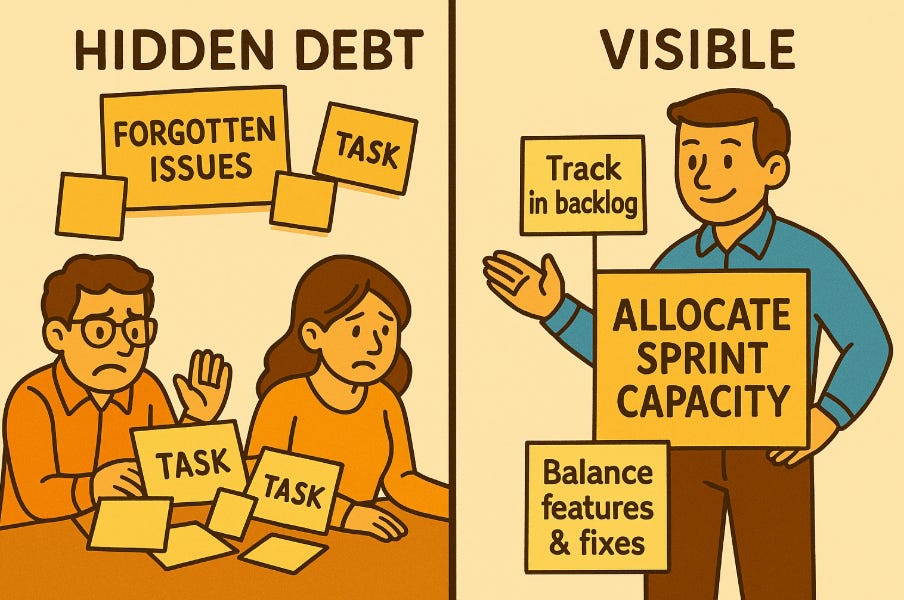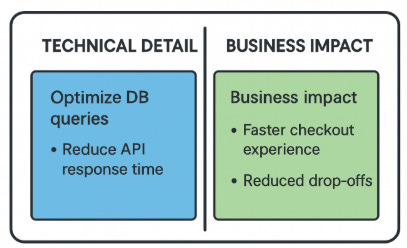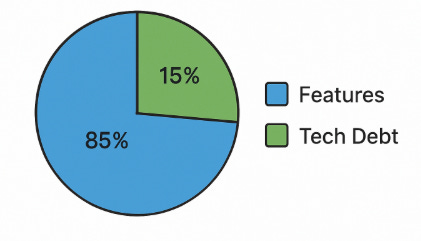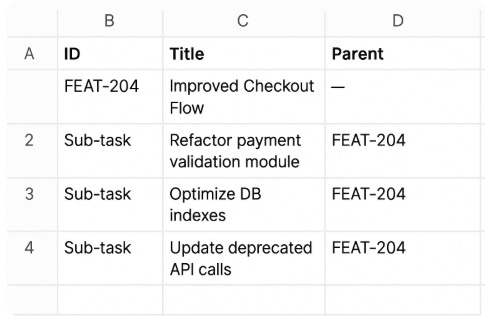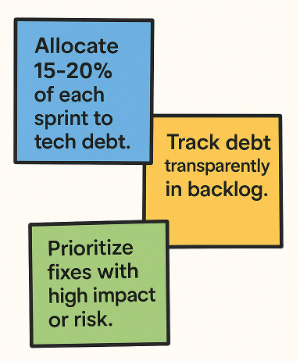5 Strategic practices to stop Tech Debt from being pushed down the Backlog
Practical steps to keep technical debt visible, valuable, and acted on!
The conversation that sparked this
I’ve been there myself.
It’s frustrating to watch the same pattern play out:
Every Sprint, we plan to fix a few tech debt items.
Every Sprint, they quietly slide to the bottom of the backlog—replaced by shiny features or urgent requests.
At first, it feels harmless.
But over time, the cracks show:
Bugs creep in more often.
Features take longer to build.
The team loses confidence in its own velocity.
Why does this happen?
More importantly—how do you stop tech debt from being postponed indefinitely?
Here’s a playbook that worked for me (and can work for you) to keep tech debt visible, respected, and acted on.
Strategy 1: Make Tech Debt visible in business terms
Tech debt is invisible unless you translate it.
Action Steps
Write backlog items in dual language: one line technical, one line business impact.
Add cost-of-delay to each debt item (e.g., “+10 hours/sprint wasted if ignored”).
Include debt stories in Sprint Reviews, presented alongside features.
Challenge: Leaders often dismiss debt as “housekeeping.”
How I overcame it: I tied each debt item to measurable metrics—speed, stability, or cost. Numbers opened ears.
Tip: The more you link debt to lost money or time, the faster it moves up the priority list.
Strategy 2: Create a debt budget in every Sprint
If you wait for “free time,” you’ll never get to it.
Action Steps
Reserve 10–20% of team capacity for debt tasks every Sprint.
Tag debt stories clearly in Jira/board.
Track predictability before vs. after the budget—it usually improves.
Challenge: Stakeholders feared slower feature output.
How I overcame It: Reframed as protecting delivery speed: without budget, velocity keeps dropping anyway.
Tip: Show trend charts proving fewer rollovers and smoother delivery once debt gets its share.
Strategy 3: Prioritise debt by risk, not preference
Not all debt is equally harmful.
Action Steps
Score debt items on Impact (1–5) and Risk (1–5).
Plot on a Risk vs. Impact matrix to highlight priorities.
Revisit quarterly with PO and tech leads to keep focus.
Challenge: Developers wanted to fix “everything.”
How I Overcame It: The scoring framework disciplined decisions. It removed bias and silenced endless debates.
Tip: Use a visual matrix—nothing convinces stakeholders faster than seeing their “ask” sitting in the “low risk/low impact” corner.
Strategy 4: Bundle Debt into Feature work
Debt is easier to sell when tied to new value.
Action Steps
During refinement, ask: “What tech debt can we address while building this feature?”
Add these as subtasks/enabler tasks under the feature.
Track defect count post-release to prove bundling reduces bugs.
Challenge: Teams feared bundling would slow down features.
How I Overcame It: Shared data: bug count dropped, future features shipped faster. That evidence won leadership buy-in.
Tip: Always celebrate “silent wins” (fewer issues, faster integration) in Sprint Review—it builds recognition for debt work.
Strategy 5: Agree on a Tech Debt policy
Sustained discipline requires shared rules, not individual effort.
Action Steps
Draft a simple 3-rule Tech Debt Policy:
Reserve Sprint capacity every cycle.
High-risk debt fixed within 2 sprints.
Every debt item must show business impact.
Share and agree in leadership syncs.
Publish visibly (Confluence, team board, posters).
Challenge: Leaders said, “Policies create bureaucracy.”
How I Overcame It: Showed how ignoring debt delayed feature delivery in the past—lost revenue spoke louder than theory.
Tip: Policies work best when leadership co-signs them—make them part of your team charter.
Reflection Question
👉 Which tech debt item has been ignored the longest in your backlog—and what’s the cost if it stays there another quarter?
Ready to Turn These Strategies into Action?
Join the Scrum Master Bootcamp!
Want to put these strategies into action and experience the impact firsthand? Join my Scrum Master Bootcamp, where you’ll work through these exact challenges and build the skills needed to drive real value in your team. This isn’t just theory — it’s hands-on practice that will transform how you manage leadership’s expectations.
👉 Click to explore more and start mastering the tools and techniques that can change the way you work as a Scrum Master.
Don’t just learn — experience the difference in real time.
Why Subscribe
Each week, I share battle-tested strategies, messy lessons, and practical tools that help Scrum Masters, Product Owners, and change agents like you make sense of chaos — without sugar-coating it.
If you found this useful, subscribe.
This isn’t theory. It’s real work, made a little easier — one step at a time.
Thanks for reading Strategy For Success! Subscribe for free to receive new posts and support my work.
📝 Your Feedback Matters!
I have started writing this newsletter and your feedback will help me improve it further. You may leave your feedback in Comment on how can I make this newsletter valuable for you.
“Just because I understand it, does not mean everyone understands it. And just because I do not understand it, does not mean no one understands it.”
Anand Pandey
Thanks for reading Strategy For Success! Subscribe for free to receive new posts and support my work.


